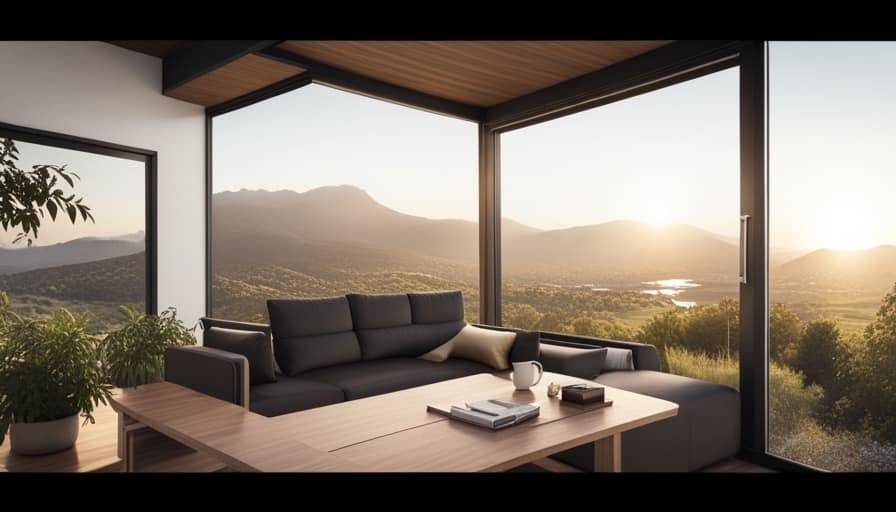Living in a compact residence emphasizes the importance of optimizing every inch of space and conserving energy. As a resident of a small house, I have become adept at maximizing efficiency in all aspects of my daily life, especially in heating my water. In my quest to lower energy consumption without sacrificing comfort, I have developed a method that enables me to use my water heater only when needed, guaranteeing that I remain cozy and warm.
In this article, I will delve into the intricacies of understanding the energy usage of a water heater in a tiny house, and explore the pros and cons of selectively using it. I will also guide you through evaluating your water heating needs, exploring alternative options, and implementing energy-saving practices.
Additionally, I will discuss the importance of considering the climate and weather conditions, utilizing water-saving techniques, and monitoring and adjusting your water heating schedule.
So, if you’re ready to take control of your water heating in your tiny house, join me on this journey to discover how you can efficiently and effectively heat your water only when you need it.
Key Takeaways
- Saving energy in water heating can be achieved by turning on the water heater only when necessary.
- Choosing a water heater designed for small spaces or a tankless water heater can reduce energy consumption.
- Insulating the water heater and pipes helps retain heat and minimize energy waste.
- Selectively using the water heater can lower energy usage, reduce carbon footprint, save costs, and extend its lifespan.
Understanding the Energy Usage of a Water Heater in a Tiny House
You can easily control when to turn on the water heater in your tiny house, allowing you to save energy and only heat water when you need it. Evaluating the energy efficiency of your water heater is crucial in order to make cost-effective choices.
Consider choosing a water heater that is specifically designed for small spaces, as it will consume less energy. Tankless water heaters are also a great option, as they only heat water on-demand, eliminating the need for standby energy consumption. Additionally, insulating your water heater and pipes will help retain heat, reducing energy waste.
However, there are pros and cons to selectively using the water heater. Let’s explore those in the next section.
Pros and Cons of Selectively Using the Water Heater
By selectively using the water heater, one can enjoy the convenience of hot water while minimizing energy consumption. There are several pros and cons to consider when deciding whether to selectively use your water heater in a tiny house:
Pros:
- Reduced energy consumption: By only turning on the water heater when needed, you can significantly lower your energy usage and save on utility bills.
- Environmental benefits: Using less energy means reducing your carbon footprint and contributing to a more sustainable lifestyle.
- Cost savings: Lower energy consumption translates to cost savings in the long run, which is especially important for tiny house dwellers looking to minimize expenses.
- Increased lifespan: By using the water heater less frequently, you can extend its lifespan and avoid costly repairs or replacements.
Cons:
- Inconvenience: Selectively using the water heater may require planning and adjusting your daily routine to ensure hot water is available when needed.
- Potential for cold showers: If you forget to turn on the water heater or misjudge your hot water needs, you may end up taking a cold shower.
Considering these factors, evaluating efficiency and cost comparisons becomes essential when deciding how often to use your water heater. Transitioning into the subsequent section about evaluating your water heating needs, it’s crucial to assess your specific requirements to make informed decisions.
Evaluating Your Water Heating Needs
Make sure to carefully assess your specific requirements when it comes to evaluating how much hot water you need. Evaluating water temperature is an essential step in determining the capacity of the water heating system you require.
Consider factors such as the number of people in your tiny house, their daily hot water usage, and the peak times when hot water is in high demand. Additionally, take into account any specific activities that may require higher water temperatures, such as dishwashing or showering.
By evaluating your water heating needs, you can ensure that you choose the right water heating system that meets your requirements efficiently.
Exploring alternative water heating options is the next logical step, as it allows you to consider different approaches and technologies that may better suit your specific needs.
Exploring Alternative Water Heating Options
When it comes to exploring alternative water heating options for my tiny house, there are three key points to consider:
- Tankless water heaters are a great option for their energy efficiency and space-saving design.
- Solar water heaters utilize the power of the sun to heat water, making them a sustainable and cost-effective choice.
- Lastly, heat pump water heaters are highly efficient and use electricity to transfer heat from the air or ground to heat water.
Tankless Water Heaters
Tankless water heaters provide hot water on demand, perfect for conserving energy in a tiny house. With tankless water heater installation, you can enjoy hot water whenever you need it without the need for a storage tank. This eliminates standby heat loss and reduces energy consumption, making it an efficient option for your tiny house.
The cost of tankless water heaters may be higher compared to traditional water heaters, but the long-term energy savings can outweigh the initial investment. Additionally, tankless water heaters are compact and space-saving, making them an ideal choice for a small living space.
Transitioning into the subsequent section about solar water heaters, another alternative water heating option, allows you to further explore sustainable and eco-friendly ways to meet your hot water needs.
Solar Water Heaters
Now that we’ve discussed tankless water heaters, let’s delve into the world of solar water heaters.
Solar water heaters are an excellent option for those looking to reduce their energy consumption and carbon footprint. The installation process for a solar water heater involves placing solar panels on your roof or in an area that receives ample sunlight. These panels absorb the sun’s energy and transfer it to a water storage tank, where it is used to heat the water.
One of the major benefits of solar water heaters is their cost-effectiveness in the long run. Although the initial installation may be expensive, solar water heaters can significantly reduce your monthly energy bills. Additionally, solar water heaters are environmentally friendly, as they rely on renewable energy.
As we move forward, let’s explore the advantages of heat pump water heaters.
Heat Pump Water Heaters
To save on energy costs and reduce your carbon footprint, consider installing a heat pump water heater. This innovative technology uses electricity to move heat from the air or ground to heat your water, similar to how a refrigerator extracts heat from its contents to keep them cool. Heat pump water heaters are highly efficient, making them an excellent choice for tiny houses. In fact, they can be up to three times more efficient than traditional electric water heaters. To give you an idea of the efficiency comparison, take a look at the table below:
| Water Heater Type | Efficiency Rating |
|---|---|
| Heat Pump | 300% |
| Electric Resistance | 100% |
| Gas | 90% |
| Solar | 70% |
By installing a heat pump water heater, you can significantly reduce your energy consumption and save money in the long run. Now let’s explore implementing other energy-saving practices to maximize efficiency.
Implementing Energy-Saving Practices
When it comes to implementing energy-saving practices for water heating, there are several key points to consider.
First, insulating your water heater can significantly reduce heat loss and improve overall efficiency.
Secondly, using a timer or a smart thermostat can help you control when your water heater is turned on, saving energy when it’s not needed.
Lastly, proper maintenance and regular inspections are essential to ensure your water heater is functioning optimally and to address any potential issues before they become major problems.
Insulating Your Water Heater
You can easily insulate your water heater to conserve energy in your tiny house. Insulating your water heater has several benefits, including reducing heat loss and lowering energy consumption.
By insulating the tank and pipes, you can prevent heat from escaping, resulting in less energy needed to heat the water. This insulation also helps to maintain the water temperature for longer periods of time, reducing the frequency of heating cycles.
Additionally, insulating your water heater is a cost-effective solution as it can save you money on your energy bills in the long run.
In the next section about using a timer or smart thermostat, you can further optimize your energy usage by controlling when the water heater operates.
Using a Timer or Smart Thermostat
Installing a timer or smart thermostat allows for better control over the operation of your water heater, resulting in increased energy efficiency and cost savings. Here are four key benefits of using a timer or smart thermostat for your water heater:
- Energy conservation: By scheduling the water heater to turn on only when needed, you can minimize energy waste and reduce your utility bills.
- Convenience: With a timer or smart thermostat, you can easily program your water heater to align with your daily routine, ensuring hot water is available when you need it.
- Manual switch option: Some timers or smart thermostats come with a manual switch feature, allowing you to override the schedule and turn on the water heater manually if required.
- Additional insulation: Along with a timer or smart thermostat, utilizing a water heater blanket can further enhance energy efficiency by reducing heat loss.
Proper maintenance and regular inspections are vital for ensuring the longevity and optimal performance of your water heater.
Proper Maintenance and Regular Inspections
To ensure the efficient operation of my water heater in my tiny house, I not only rely on timers or smart thermostats but also prioritize proper maintenance and regular inspections. By adhering to a maintenance schedule, I can identify and address any potential issues before they become major problems. This includes inspecting the water heater for any signs of corrosion, leaks, or faulty components. Regularly flushing the tank helps remove sediment buildup, improving the heater’s performance and extending its lifespan. To assist you in visualizing the importance of proper maintenance and inspections, consider the following table:
| Maintenance Task | Frequency | Benefits |
|---|---|---|
| Inspect for leaks | Monthly | Prevent water damage |
| Flush the tank | Annually | Improve efficiency |
| Check for corrosion | Semi-annually | Prevent breakdowns |
By diligently maintaining and inspecting my water heater, I can ensure its optimal performance and longevity. Now, let’s delve into considering the climate and weather conditions when it comes to water heater usage.
Considering the Climate and Weather Conditions
When considering the climate and weather conditions, it’s important to take into account the impact of cold climates and winter months.
In these conditions, energy usage tends to increase as heating systems are utilized more frequently.
On the other hand, warm climates and summer months also have their own energy challenges.
There’s an increased use of air conditioning systems and the need to find ways to stay cool while minimizing energy consumption.
Cold Climates and Winter Months
You can easily control the water heater in your tiny house during cold climates and winter months, like a master conductor guiding an orchestra. When evaluating water consumption, it’s important to consider the climate and weather conditions.
In cold climates, it’s crucial to prevent frozen pipes, which can cause serious damage to your tiny house. To do this, you can insulate your water pipes and use a heat tape or pipe heater to keep them warm. Additionally, you can install a thermostat that automatically adjusts the water heater temperature based on the outside temperature. This will ensure that your water stays hot without wasting energy.
As we transition into discussing warm climates and summer months, it’s important to note that controlling the water heater in these conditions requires a different approach.
Warm Climates and Summer Months
Now that we’ve discussed the challenges of cold climates and winter months in relation to water heating in tiny houses, let’s explore how warm climates and summer months can affect our water heating needs.
In these hotter months, we often find ourselves using more water for various purposes such as showers, laundry, and dishwashing. However, it’s important to be mindful of water conservation techniques and reducing water heating costs in order to be environmentally conscious and cost-effective.
To achieve this, there are several strategies you can implement:
- Installing low-flow showerheads and faucets to reduce water usage.
- Insulating your water heater and pipes to minimize heat loss.
- Utilizing natural sources of hot water, such as solar water heaters or heat pumps.
By incorporating these techniques, you can optimize your water heating system’s efficiency, conserve water, and save money on energy bills.
Transitioning into the next section, let’s now explore how we can further maximize water conservation by utilizing water-saving techniques throughout the entire tiny house.
Utilizing Water-Saving Techniques
To maximize water efficiency in your tiny house, try using water-saving techniques like only turning on the water heater when needed. By implementing these water conservation strategies, you can significantly reduce your water consumption and minimize energy wastage.
One effective technique is to install low-flow faucets and showerheads, which decrease the amount of water used without compromising on functionality. Additionally, consider using a graywater system to reuse water from sources such as sinks and showers for purposes like irrigation. Another approach is to insulate your water pipes to reduce heat loss, enabling faster hot water delivery and minimizing the need for continuous heating.
By adopting these water-saving techniques, you can not only reduce your environmental impact but also save on water and energy costs.
Transitioning into the subsequent section about monitoring and adjusting your water heating schedule, it’s essential to find a balance that meets your needs while minimizing waste.
Monitoring and Adjusting Your Water Heating Schedule
Keep a close eye on the clock and adjust your water heating schedule accordingly, ensuring that you strike the perfect balance between warmth and conservation.
Monitoring water temperature is crucial in managing your water heater effectively. By regularly checking the water temperature, you can identify any fluctuations or inefficiencies in your system.
If the temperature is consistently too high or too low, it may be necessary to adjust the water heater settings. Depending on the type of water heater you have, this can usually be done through the thermostat or control panel. Making small adjustments can help optimize energy usage and prevent unnecessary water heating.
Keep in mind that seeking professional advice and consultation is always a wise step when it comes to your water heater. It can provide valuable insights and ensure you make informed decisions for your tiny house.
Seeking Professional Advice and Consultation
When seeking professional advice and consultation for adjusting my water heating schedule in my tiny house, I would consult a plumber or HVAC specialist who has expertise in water heating systems. They can provide valuable insights and recommendations on optimizing the schedule to ensure efficient usage and cost savings.
Additionally, researching local building codes and regulations is crucial to ensure compliance and safety when making any adjustments to the water heating system.
Consulting a Plumber or HVAC Specialist
Contact a plumber or HVAC specialist who can help you figure out the best way to control your water heater in your tiny house. They have the expertise to evaluate your water pressure and troubleshoot common issues that may arise with your water heater. Here are four steps they may take to assist you:
- Assessing your current water heater system and determining if it’s compatible with your tiny house setup.
- Suggesting alternative water heater options that’re more energy-efficient and suitable for your specific needs.
- Installing a water heater timer or programmable thermostat to regulate when the water heater turns on and off.
- Providing advice on proper maintenance and care of your water heater to ensure its longevity and optimal performance.
After consulting with a plumber or HVAC specialist, you can move on to researching local building codes and regulations to ensure that your water heater setup complies with the necessary standards.
Researching Local Building Codes and Regulations
Researching local building codes and regulations is like navigating a complex maze to ensure that my water heating system meets the required standards. It is crucial to understand the building restrictions and obtain the necessary local permits before installing or modifying any water heater in my tiny house. To simplify the process, I have created a table summarizing the key points of my research:
| Building Codes | Permits Required | Restrictions |
|---|---|---|
| Minimum clearance for water heater | Yes | Must be installed in an approved location |
| Ventilation requirements | Yes | Adequate ventilation must be provided |
| Plumbing connections | Yes | Must comply with local plumbing codes |
| Electrical connections | Yes | Must be installed by a licensed electrician |
| Safety features | Yes | Must meet the standards for temperature and pressure relief valves |
By thoroughly researching and understanding the local building codes and regulations, I can ensure that my water heating system is safe, efficient, and compliant with the necessary standards.
Frequently Asked Questions
Can I use a tankless water heater in my tiny house?
Yes, I can use a tankless water heater in my tiny house. The benefits of using a tankless water heater include energy efficiency, space-saving design, and the option to choose between propane or electric models.
Are there any government incentives available for installing energy-efficient water heaters in tiny houses?
Yes, there are government incentives available for installing energy-efficient water heaters in tiny houses. These incentives aim to promote the use of eco-friendly technologies and can help offset the cost of purchasing and installing such systems.
What are some common mistakes to avoid when implementing energy-saving practices for water heating in a tiny house?
Common mistakes to avoid when implementing energy-saving practices for water heating in a tiny house include using an oversized water heater, neglecting insulation, and failing to use a timer or smart thermostat. Best practices include proper sizing, insulation, and efficient temperature control.
How can I effectively monitor and adjust my water heating schedule in a tiny house?
To effectively monitor and adjust my water heating schedule in a tiny house, I can optimize usage and increase efficiency by implementing a system that tracks energy consumption, using smart thermostats or timers to control heating cycles.
What are some potential risks or drawbacks of selectively using the water heater in a tiny house?
Potential risks and drawbacks of selectively using the water heater in a tiny house include a higher risk of bacteria growth due to infrequent use and an inconsistent hot water supply, which may not meet your needs consistently.
Conclusion
In conclusion, managing the water heater in a tiny house requires thoughtful consideration and strategic planning. By evaluating your water heating needs and exploring alternative options, you can effectively control the usage of your water heater. Implementing energy-saving practices is also important.
Additionally, considering the climate and weather conditions, utilizing water-saving techniques, and monitoring and adjusting your water heating schedule are crucial steps to optimize efficiency. Seeking professional advice and consultation can further enhance your understanding and help you make well-informed decisions. Remember, when it comes to managing your water heater, a stitch in time saves nine, ensuring long-term cost savings and environmental sustainability.
I’m Theodore, and I love tiny houses. In fact, I’m the author of Tiny House 43, a book about tiny houses that are also tree houses. I think they’re magical places where imaginations can run wild and adventures are just waiting to happen.
While tree houses are often associated with childhood, they can be the perfect adult retreat. They offer a cozy space to relax and unwind, surrounded by nature. And since they’re typically built on stilts or raised platforms, they offer stunning views that traditional homes simply can’t match.
If you’re looking for a unique and romantic getaway, a tree house tiny house might just be the perfect option.










